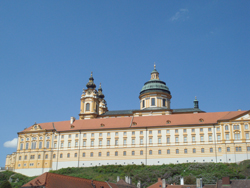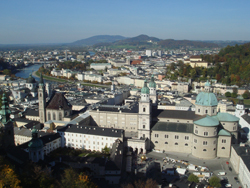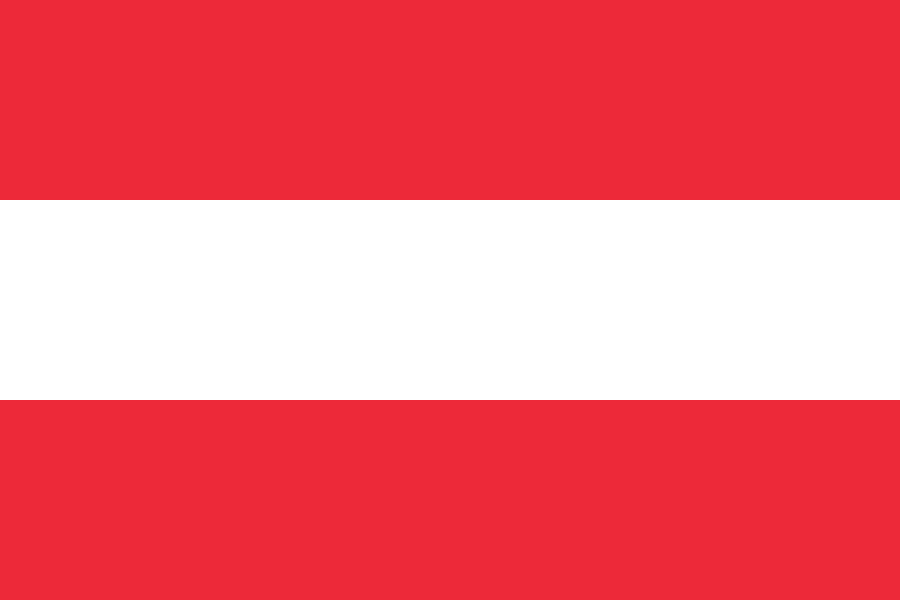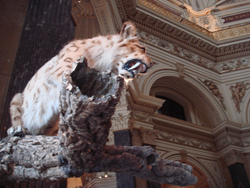 This morning we decided to spend some time in the museum district
of Vienna. One of the
great advantages of visiting a former imperial capital, is
that they are invariably packed with goodies either plundered
from the colonies or paid for from the proceeds of colonies.
And Vienna is no exception.
When the city fortifcations were demolished in the 19th century
several new buildings were erected including the Natural
History Museum and the Art
History Museum which would be the targets of our visitation
this morning. Marie Therese, one-time Empress of Austro-Hungary,
dominates the squares between the two museums atop an impressive
statue.
This morning we decided to spend some time in the museum district
of Vienna. One of the
great advantages of visiting a former imperial capital, is
that they are invariably packed with goodies either plundered
from the colonies or paid for from the proceeds of colonies.
And Vienna is no exception.
When the city fortifcations were demolished in the 19th century
several new buildings were erected including the Natural
History Museum and the Art
History Museum which would be the targets of our visitation
this morning. Marie Therese, one-time Empress of Austro-Hungary,
dominates the squares between the two museums atop an impressive
statue.
Our first stop was the Natural History Museum which would not normally have been a stop for us. But I'd seen a picture of the interior of the building. Actually, the coffee shop and really wanted to have a rummage around the building that is the neo-Renaissance Natural History Museum. Of course, while here we had a look around for the Venus of Willendorf a fertility symbol which, apparently, dates from around 25,000 years. I'm no expert on fertility symbols (I prefer to do fertility over fertility symbols) but Venus of Willendorf is, without a shadow of a doubt, a voluptuous woman - Rubensesque before Rubens. Well before Rubens!
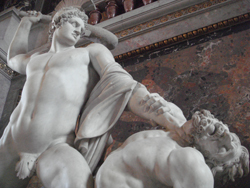 The Art
History Museum is what I was looking forward to today.
Like the Natural History Museum opposite, it's a grandiose,
impressive building with stair cases to match. The collection
is an impressive array of well known masters of a whole array
of periods and nations including Rubens, Tintoretto, Raphael,
Vel�zquez and Caravaggio.
The Art
History Museum is what I was looking forward to today.
Like the Natural History Museum opposite, it's a grandiose,
impressive building with stair cases to match. The collection
is an impressive array of well known masters of a whole array
of periods and nations including Rubens, Tintoretto, Raphael,
Vel�zquez and Caravaggio.
While it is, without a doubt, possible to spend a full day in the Art History Museum we concentrated our visit on the Rubens, Titian, Tintoretto and Caravaggio sections on the first floor. We had intended to visit the Collection of Sculpture and Decorative Arts as well, but this was unfortunately closed on this visit.
One of the greatest pieces of artwork in the Museum is the painting of David and Goliath by Caravaggio in 1606 / 1607. Unlike the versions in the Prado Museum in Madrid or the Galleria Borghese in Rome this David and Goliath has a more melancholy nature - almost reflective in a way that the brutal Prado version or the violently pentitent Galleria Borghese versions lack. Yet it also retains all the essential elements of drama, darkness and movement that have made Caravaggio one of the most recognised and influential artists of the Baroque period.
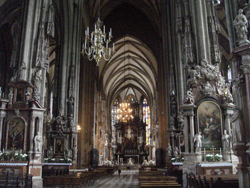 We
headed back to the Cathedral
of St Stephan for the twice-daily guided tour (4.50EUR)
of the interior. Our informative guide, who spoke excellent
English, took us through the St Stephans Cathedral and introduced
us to the key features of the Cathedral. Built in the Gothic
style, the Cathedral was constructed on the site of two previous
churches. After the first church burnt down, a second was constructed
in the Romanesque style - which is in evidence at the current
main entrance to cathedral. The main entrance, both on the
interior and exterior, exhibit features from the Romanesque
style of building including the Romanesque arching and decorations.
The remainder, however, is pure Gothic with pointed arches
and vaulted cieling.
We
headed back to the Cathedral
of St Stephan for the twice-daily guided tour (4.50EUR)
of the interior. Our informative guide, who spoke excellent
English, took us through the St Stephans Cathedral and introduced
us to the key features of the Cathedral. Built in the Gothic
style, the Cathedral was constructed on the site of two previous
churches. After the first church burnt down, a second was constructed
in the Romanesque style - which is in evidence at the current
main entrance to cathedral. The main entrance, both on the
interior and exterior, exhibit features from the Romanesque
style of building including the Romanesque arching and decorations.
The remainder, however, is pure Gothic with pointed arches
and vaulted cieling.
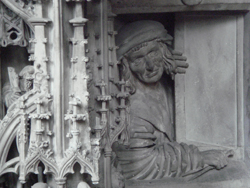 One
of the more interesting items of note is the pulpit (pictured)
and is regarded as a masterpiece of Gothic sculpture. One of
the more intriguing aspects of the pulpit is the "Fenstergucker" -
a man underneath the pulpit peering out of a window. Thought
to be the sculptor of the pulpit the man was originally thought
to be Anton Pilgram but, after much debate, the person could
also be Niclaes Gerhaert van Leyden.
One
of the more interesting items of note is the pulpit (pictured)
and is regarded as a masterpiece of Gothic sculpture. One of
the more intriguing aspects of the pulpit is the "Fenstergucker" -
a man underneath the pulpit peering out of a window. Thought
to be the sculptor of the pulpit the man was originally thought
to be Anton Pilgram but, after much debate, the person could
also be Niclaes Gerhaert van Leyden.
On the main surround of the pulpit itself, the four original Doctors of the Church (St. Augustine of Hippo, St. Ambrose, St. Gregory the Great and St. Jerome) are depicted and the handrail leading up the pulpit depicts, using animals such as dogs and salamanders depict the eternal struggle between good and evil.
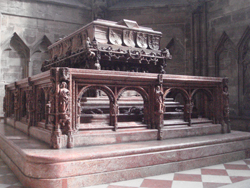 We
also visited the tomb of Frederick III, the Holy Roman Emporer,
under whos reign, the Diocese of Vienna was canonically erected
in 1469. The sarcophagus took 45 years to construct from a
red-stone from the Ayden quarry and is thought to be the works
of Niclaes Gerhaert van Leyden.
We
also visited the tomb of Frederick III, the Holy Roman Emporer,
under whos reign, the Diocese of Vienna was canonically erected
in 1469. The sarcophagus took 45 years to construct from a
red-stone from the Ayden quarry and is thought to be the works
of Niclaes Gerhaert van Leyden.
After our tour of the highlights of the Cathedral, we headed off the tour of the Catacombs in the Cathedral which, let it be known, is a maccarbe affair. The Catacombs, which stretch under the present day St Stephans Square, were closed in the 18th Century as a result of the stentch. The wooden coffins in many of the collective graves have decomposed revealing the now bare bones of the deceased. Fifty-six urns contain the entrails of the Habsburg rulers of the Austro-Hungrian empire. This is certainly not for the faint of heart.
This evening we took dinner in the historic Melker Stiftkeller (Schottengasse 3, 1010 Vienna) which was acquired by the Benedictine monastry at Melk in 1483 and has been used as an official residence of the Abbots of the monastry when on official business in Vienna. In 1944, bombs damaged the building which was rebuilt after WW2. In 1995, the top floor was turned into apartments.
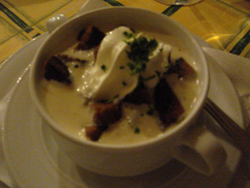 For
dinner, we selected a bottle of the Jamek
Federspiel Grüner Veltliner - a quite delicious white
wine from the Wachau Valley with flavours of peach and straw.
For starters, I took the garlic soup which, creamy as it was,
was excellently enjoyable but not as fine as Goulasch soup
m'learned colleague partook of. The Blutwurst (Black Pudding)
was also fine which was served with very fresh, fine Bärlauch and
fried potatoes. M'learned colleague took the knuckle of pork
which was served alongside a bread dumpling, sauerkraut and
horseradish. Both dishes were excellent - the Black Pudding
not as harsh or as coarse as its English equivalent, the knuckle
of pork tender and nicely cooked. The sauerkraut was surprisingly
enjoyable and amongst the finest I've tried.
For
dinner, we selected a bottle of the Jamek
Federspiel Grüner Veltliner - a quite delicious white
wine from the Wachau Valley with flavours of peach and straw.
For starters, I took the garlic soup which, creamy as it was,
was excellently enjoyable but not as fine as Goulasch soup
m'learned colleague partook of. The Blutwurst (Black Pudding)
was also fine which was served with very fresh, fine Bärlauch and
fried potatoes. M'learned colleague took the knuckle of pork
which was served alongside a bread dumpling, sauerkraut and
horseradish. Both dishes were excellent - the Black Pudding
not as harsh or as coarse as its English equivalent, the knuckle
of pork tender and nicely cooked. The sauerkraut was surprisingly
enjoyable and amongst the finest I've tried.
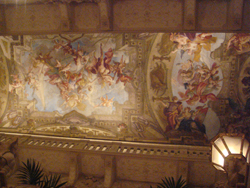 Heading
back to base we stumbled accross the open doors of the Im
Kinsky auction house (Freyung
4.) We noticed the open doors to the courtyard and decided
to have a peer inside and examine the statues nestled carefully
and elegantly in their niches.
Heading
back to base we stumbled accross the open doors of the Im
Kinsky auction house (Freyung
4.) We noticed the open doors to the courtyard and decided
to have a peer inside and examine the statues nestled carefully
and elegantly in their niches.
What we hadn't realised was that a set of doors were open leading to a large and impressive stair casing with an impressive frescoed cieling - which we strolled upto. An event appeared to be on in one of the meeting rooms (we could hear the applause) so took a few moments to admire the cieling and headed forth into the darkness of the night.
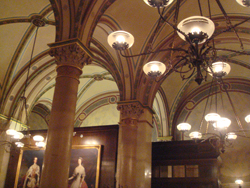 It
wasn't long into the darkness that the lights streamed out
of the Cafe
Central (Herrengasse
17) a still famous once-literatti hangout. So we popped
in for a melange for m'learned colleaque and a glass of Grüner
Veltliner for your current interlocuter. The Central is certainly
a beautiful place to stop for an apres-supper beverage which
is slightly let down by the shcokingly shoddy service. Were
it not for the piano-player, beautiful vaulting and impressive
portraits of Sisi and Francis Joseph I on the wall we would
have been outta here before we'd been served.
It
wasn't long into the darkness that the lights streamed out
of the Cafe
Central (Herrengasse
17) a still famous once-literatti hangout. So we popped
in for a melange for m'learned colleaque and a glass of Grüner
Veltliner for your current interlocuter. The Central is certainly
a beautiful place to stop for an apres-supper beverage which
is slightly let down by the shcokingly shoddy service. Were
it not for the piano-player, beautiful vaulting and impressive
portraits of Sisi and Francis Joseph I on the wall we would
have been outta here before we'd been served.
